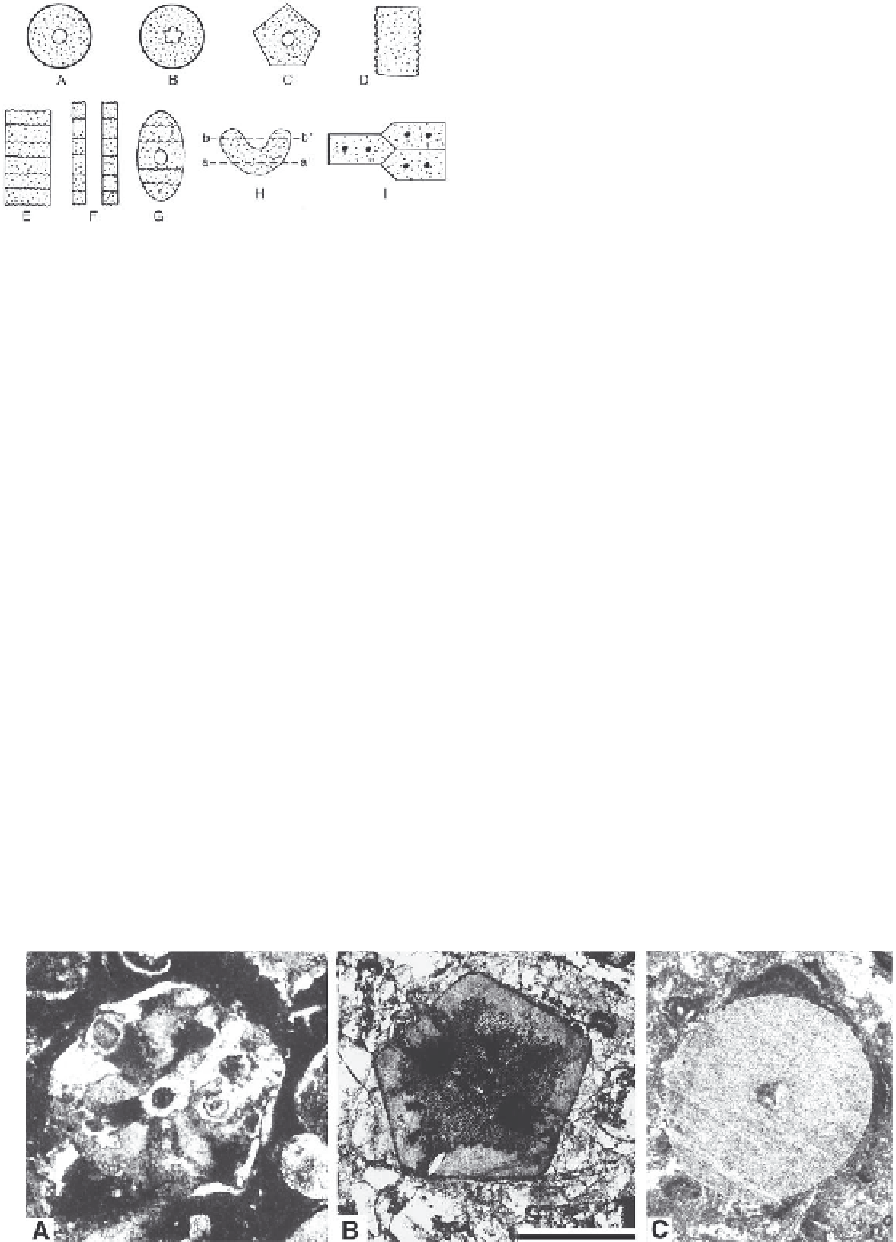Geology Reference
In-Depth Information
hydraulically sorted components of tempestites, in
crinoidal mounds (Becker and Dodd 1994) on slopes
and in basins. Widely extended 'regional encrinites'
(Ausich 1997) were deposited below normal wave base
but within storm wave base. Crinoid limestones are re-
garded as a specific standard microfacies type (see Pl.
119/2, Pl. 139/6). Post-Cretaceous crinoid deposits are
rare, because of the change in the habitat of stalked
crinoids from shallow shelf and upper slope environ-
ments to deeper-water basinal environments.
Crinoids thrived in carbonate settings to siliciclas-
tic-dominated settings. Limestones rich in crinoids ex-
hibit differences in the abundance and composition of
crinoidal elements, indicating various taphonomic pro-
cesses and differences in the depositional environment:
(a) Many primary crinoid packstones consist almost
exclusively of isolated, often worn disks and plates.
This may indicate in-place degradation or deposition
subsequent to transport. These packstones (encrinites)
can form thick beds. (b) Crinoid ossicles may also oc-
cur within bioclastic wackestones and marly limestones,
but to a minor percentage and admixed with other skel-
etal grains. This may indicate transport prior to deposi-
tion. (c) Long stems and even well-preserved crowns
occur in marly limestones and marls. This characterizes
more or less autochthonous burial in quiet-water set-
tings.
Crinoidal limestones (usually wackestones and pack-
stones, rarely grainstones) originated in place by au-
tochthonous or parautochthonous deposition of crin-
oidal elements or allochthonous subsequent to trans-
port (Cain 1968):
Fig. 10.53.
Schematic drawings of common
sections of echi-
noderm plates.
A
and
B
: Cross sections of crinoid columnals
differing in the shape of the central lumina.
C
: Columnal dif-
fering from A and B in the pentagonal outline of the stem
plate.
D
: Section of a stem showing the serrate outline of the
articulated surfaces.
E
: Series of stem plates displaying ser-
rated outlines of stem surfaces.
F
: Same as E but section pass-
ing through the lumen.
G
: Oblique section through a crinoid
stem.
H
: Lunate crinoid arm plate. Sections along a-a' and
b-b' will create different pictures,
I
: Echinoid pore plates par-
allel to the surface of the plates. Modified from Horowitz
and Potter (1971).
solid carbonate particles of the same size (Savarese et
al. 1997).
Stalkless crinoids (feather stars) appeared in the Me-
sozoic. Today they live in shallow-marine waters, e.g.
reefs. Their isolated elements may be conspicuous con-
stituents of Mesozoic open-marine limestones.
Crinoid limestones
Crinoid limestones are commonly formed by mass
accumulations of benthic crinoid elements, but can also
originate from the deposition of fragments of pelagic
free-living crinoids.
Benthic crinoidal limestones
are formed in different
marine depositional environments. Mass accumulations
of crinoids occur in reef flank beds (Pl. 144/4-6), as
In-place deposition
occurred in reef, near-reef (Fig.
10.55; Pl.143/1), and far-reef settings (Ruhrmann
1971a, 1971b), in crinoidal mounds (Becker and Dodd
Fig. 10.54.
Isolated crinoid columnals in thin sections
differing in outlines and surface ornamentation.
A
: Pentagonal stem
plate with several ringlike cirri sockets. Early Jurassic (Sinemurian): Klauskogel near Hallstatt, Austria.
B
:
Pentacrinus
exhibiting the original meshlike microstructure especially in the center. Early Permian: Southern Anatolia, Turkey.
C
: Circu-
lar stem plate. The original microstructure has largely vanished. Note cleavage planes. The columnal is encrusted by fora-
minifera. Late Carboniferous: Rosskofel, Carnic Alps, Austria. Scale is 1 mm.

